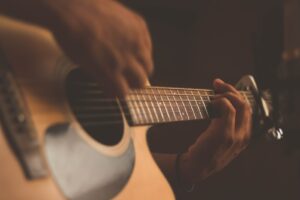A capo is a tool commonly used by guitarists to alter the pitch of their instrument without changing individual strings’ tunings.
It resembles a clamp placed on an instrument’s fretboard, shortening strings’ length while raising the pitch.
Capos are often associated with acoustic guitars, but many guitarists also wonder if they can use one on an electric guitar.
The mechanics for using a capo on an electric guitar are virtually the same as those for an acoustic guitar.
The main distinction between electric guitars and basses lies in their tone.
Electric guitars create sound through pickups and amplifiers, which can be altered through effects pedals and EQ settings.
Impact Of Placing A Capo On An Electric Guitar
The standard tuning on a guitar calls for the sixth string (the thickest) to be tuned to E. However, when using capo tuning on the third fret, this pitch will be raised to G.
While other tunings and capo placements are possible, using a capo creates the effect as if all six strings were fretted elsewhere – giving you access to open chords instead of barre chords. Capo in a song allows players to adjust it without relearning difficult patterns.
Shortening the string length will enable chords to be played as if they were still in E, but with open chords instead of a barre chord.
This is particularly helpful for songs with specific picking patterns. Additionally, capos can alter a song’s key to better suit the singer’s vocal range.
Placing a capo is far simpler than altering tuning for one song, especially when multiple steps need changing simultaneously.
For those familiar with barre chords, a capo can serve as an index finger replacement that eliminates the need to fret all six strings – making it simpler to play some songs.
Actions to Avoid While Using a Capo on a Guitar
Avoid Tuning the Guitar Afterwards
Avoid tuning your guitar with a capo because the strings are already fretted at a certain point depending on where the capo is placed, and tuning them in this condition could result in string breakage or failure to tune the guitar properly.
It’s best to remove the capo and tune the guitar without it, which is easy to do to prevent any extra tension on the strings.
However, if your guitar goes out of tune when you put the capo on, it could be due to either incorrect capo placement such as an uneven or bent string or intonation issues with the guitar itself. In any case, there’s no valid reason to tune your guitar with a capo on.
Avoid Excessive Use of Capo
An important factor to consider is excessive capo usage.
While it’s acceptable to temporarily use a capo when playing the guitar, leaving it on the guitar when not in use isn’t recommended.
This is especially relevant for acoustic guitars, which already have tension issues.
Leaving the capo on could cause neck warping since acoustic guitars lack truss rods like electric guitars do.
Prolonged usage of a capo may damage it; although more crucial than looking after your guitar’s neck, taking care of it will considerably prolong its lifespan.
Do Electric and Acoustic Guitars Require Different Types of Capos?
A capo is an invaluable tool for guitarists to alter the key of a song without altering their guitar tuning.
Different guitar types have unique neck widths, fingerboard radii, and string gauges which may affect how a capo performs on your instrument.
A capo designed for steel-string acoustic or electric guitars may not fit well on classical guitars due to differences in fingerboard width and curvature.
Classical guitars typically feature wider and flatter fingerboards than their steel-string counterparts.
Using a standard capo on one may not provide enough pressure on the strings, leading to buzzing noises or out-of-tune sounds.
Is The Neck Of An Acoustic Guitar Wider Than That Of An Electric Guitar?
Acoustic guitars are renowned for their distinctive sound and versatile playing style. Acoustic have wider necks than electrics due to the fingerpicking or complex chord playing associated with acoustic guitars.
The wider neck of an acoustic guitar provides more space between the strings, making it easier for players to fingerpick and perform complex chord shapes.
This characteristic produces a fuller and mellower sound when strumming, creating more room for vibration between strings and resulting in warmer tones.
This wider neck enhances its unique sound and playing style, and more comfortable fingerpicking is possible, and strumming produces a fuller and warmer tone.
As A Beginner On The Electric Guitar, Is It Necessary To Have A Capo?
A capo is a tool as guitarists use to alter the pitch of their guitar’s strings by shortening their length.
This tool sits on top of the neck and raises the pitch of each string, making certain chord formations easier and more accurate.
A capo can enhance playing music in different keys by simplifying certain chord formations. The capo is an invaluable aid for beginners on their guitar learning journey.
With it, novices could play songs with multiple chords; however, with a capo, they can easily and confidently access a larger repertoire of songs.
Guitarists using a capo to learn a song may initially struggle with chord shapes and finger positions.
They will begin to see progress and experience a sense of gratification as their abilities grow and they add more songs to their repertoire.
What Is The Reason Behind Guitarists Using Capos?
Capos can be especially helpful for guitarists when playing songs on different keys.
By placing the capo on a specific fret, musicians can adjust the pitch of their open strings while easily maintaining familiar chord shapes.
Capos allow players to explore key variations without learning new chords or transposing the song into another key. Not only that, but when used properly, they can enhance the tonality of a piece significantly.
Open-string chord shapes offer guitarists a more resonant and sustained tone than bar chords, typically featuring muted or dampened notes.
These natural soundscapes create a more fluid texture to their music, adding to its charm.
Capo is an invaluable technique for guitarists; it allows them to switch keys while improving the instrument’s tonality freely.





